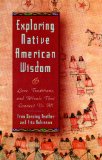
Exploring Native American Wisdom: Lore, Traditions, and Rituals That Connect Us All
, by Fran Dancing Feather and Rita Robinson
New Page Books, 1564146251, 241 pages (+ index), 2003
Fran Dancing Feather and Rita Robinson write about our ancestors, all of us, not just the Native American ancestors and Elders. They deal early on with the blending of cultures which compose the background of most people in the United States today. I can identify with their explanation, since my children have strains of African American, Native American, and European in their backgrounds (that we are sure of). We have endeavoured over the years to make sure that they have been exposed to all the various cultures which have contributed to who and what they are, as well as to any other culture which they might happen to encounter in their day-to-day lives. They have emphasized different strains at different times, but that is only to be expected. They acknowledge each culture in their own way.
Ms. Dancing Feather and Mr. Robinson mention a concept I have not seen in print for many years – that of the Himalayan temple dedicated to the Ascended Masters. Not since my brief encounter with Theosophy have I seen anyone seriously discuss this concept, and I was a little surprised to run across it in this book, although it shows the breadth of their respect for all ancestors.
One of the things I found most intriguing, and valuable, is their practice of summarizing each chapter as it draws to a close. In this way, the high points are reinforced and made easier to remember.
While there are occasional editing glitches, overall this is a very well written book. Their style of writing does tend to be a bit on the dry side, and if the topic is not one that you feel drawn to out of a deep necessity, you may have trouble getting into it. Of course, in my case, I have a backlog of books to read, so I like to get swept up in the writing. (I normally allow myself two weeks to read a book, and I needed every day of that time for this book.)
This book is Native American only in that the authors write from such a perspective. The principles they enumerate can be used by anyone, of any religious orientation. If you take the time to work with these ideas, you will derive plenty of benefit.
This book offers some good insights into Native culture. It is meant to be digested slowly. Do not expect brilliant flashes of insight, or major examples of life-changing behavior. What this book will give you is a way to slowly transform your life, whether or not you are Native American.
The authors explain, from the point of view of “totem animals” how the animal kingdom relates to the world of man, and what we can learn from them
The book ends by describing the forms and sights of Native Pow Wows, the different dances which are a part of those gatherings, and the honour due to Native American (and all other) warriors, as well as maintaining a comfortable home.
Although I had some difficulties with this book, I would recommend it to anyone looking for a Native American perspective. Those who have a strong background in Native American beliefs will not gain much, but the rest of us will find it enlightening.








